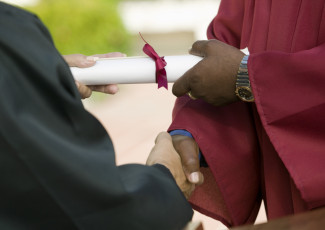A National Reverse-Transfer Initiative
By Sonya Stinson
September 3, 2015
How the process unfolded at Austin Community College.
The University of Texas at Austin and it’s main transfer-student feeder school, Austin Community College, are ground zero for the development of a national Reverse Transfer initiative that could confer associate degrees on nearly 2 million students who left a community college without a diploma. UT-Austin is leading the effort, using Texas’ successful statewide Reverse Transfer system as a model. Already, Missouri, Ohio and Tennessee are working on programs similar to the one in Texas.
Richard Rhodes, president and CEO of Austin Community College, got the Reverse Transfer movement started when he was president of El Paso Community College. He says the idea was prompted by his daughter’s college experience. She was continuing her studies at his college after having taken some courses at Salt Lake Community College, when the family lived in Utah. But when she got ready to go to Arizona State University to pursue her bachelor’s degree, she wasn’t going to bother documenting her combined community college credits to earn an associate degree, but Rhodes persuaded her to do so.
“It got me to wondering how many students have met all the requirements to get an associate degree if they combined the hours from multiple institutions, but they either don’t realize it or they don’t care,” Rhodes says.
Rhodes and other college administrators worked out an agreement with the University of Texas at El Paso to allow El Paso Community College to award degrees to the estimated 600 to 700 students a year who met the requirements because of the credits they had accumulated.
How to make reverse transfer happen
When Rhodes arrived at Austin Community College, in 2011, he was eager to start a Reverse Transfer program, but the process was a little more complicated. Unlike the one-to-one institutional partnership in El Paso, the Austin system would have to deal with several four-year schools to which local students transferred. It was then that those involved in the effort began to look at the feasibility of scaling it across the state.
As chairman of the Texas Student Success Council, Rhodes helped get the state’s standard admission application changed to include students’ authorization for UT to transfer their grades back to any community college in the state. By 2014, a year after that change was implemented, the number of students receiving Reverse Transfer–based degrees from Austin Community College had gone from zero to 202, Rhodes says. A year later, the number had doubled.
“My guess is, next year it’s going to go up to 600 or 700,” he says.
Another major step in the process was getting the Texas legislature to pass a bill requiring all state public universities to allow credits to transfer back to community colleges once students rack up a certain number of hours. After initially setting the threshold at 90 hours, lawmakers reduced it to 66 hours. To make the system work efficiently, Texas legislation also authorizes the state’s institutions to share information with the National Student Clearinghouse, which sends data between community colleges and universities. The clearinghouse will have a similar role in supporting the national initiative.
Rhodes says the key to Texas’ success with Reverse Transfer is having good collaboration among the institutions involved, along with the will and persistence to get it done. While Texas college administrators had to enlist the help of the legislature to make the complex system work, Rhodes says that step may not be necessary in every state.
Research shows students with two-year degrees are nearly twice as likely to attain a bachelor’s degree as those without that credential under their belt. Even associate degree earners who don’t finish at a four-year college have better employment opportunities.
“This is exciting for students,” Rhodes says. “It’s exciting for people that want to go into the workforce, and sometimes all they’re missing is a recognized credential. Now they have a way to get that, based on what they’ve already achieved.”









